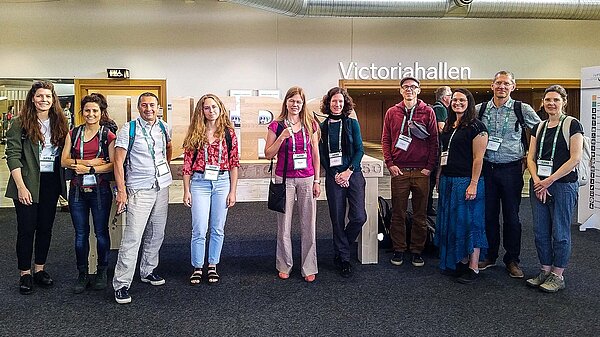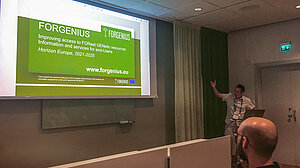Genetics meets… all other fields: a FORGENIUS-sponsored session at the IUFRO 2024 congress in Stockholm, Sweden
| by Ivan Scotti (INRAE)
More than four thousand people convened in the southern outskirts of Stockholm from 24 June to 29 June 2024 for the 2024 IUFRO (International Union of Forest research Organisations) world congress, in a surprisingly hot beginning of summer, with temperatures as high as 30° C or even more.
A vast number of parallel sessions were staged during the week. One of these, session T3.26 “Multi-disciplinary approaches to the modelling of FGR resilience: there's more than genetics to Forest Genetic Resources” (look it up in the conference’s detailed programme), was sponsored and organised by the FORGENIUS team, and co-chaired by FORGENIUS’ coordinator, Ivan Scotti, and by FORGENIUS members Marjana Westergren and François Lefèvre. Approximately seventy people attended the session, where six speakers took turns to illustrate ways to characterise the diversity of forest tree populations—not only from the standpoint of genetic diversity.
Keynote speaker Meredith Schumann (University of Zurich, Switzerland) showed how remote sensing can be used to describe the diversity of wild forest tree stands and to account for their genetic and functional status, greatly increasing the throughput in the characterisation of individual trees. Astor Torano Caicoya (Technical University Munich, Germany) showed how maintaining diversity in forest tree plantations has a beneficial effect on the performances of single trees and whole stands; such effects can be obtained at all levels of diversity, from inter-individual to provenance to species.

Sanna Olsson (INIA-CSIC, Madrid, Spain), described how the FORGENIUS programme is bringing about the characterisation of whole forests from the point of view of genetic diversity, adaptive traits, heritability of traits, fertility, realised fecundity, and ultimately adaptive potential, in an impressive display of multi-disciplinary work. Victor Fririon (INRAE-URFM, Avignon, France) explained how the use of demo-genetic models of silviculture and environmental disturbance allows the prediction of the evolution of adaptive traits in a simulated managed forest stand. Claire Depardieu (University of Laval, Canada) demonstrated how information carried by tree ring width, measured over years varying the intensity of drought conditions, can be used to obtain precise and powerful estimates of the resilience of populations to disturbance, and lead to moderate to high estimates of the heritability of such adaptive plasticity.
Finally, Silvio Oggioni (University of Milan, Italy) concluded with an optimistic note on the state of silver fir forests in the Appenines, showing that growth rates of the conifer’s wild stands suggest a high potential for adaptation to the environmental conditions that climate change will produce in the near future.
The session concluded with a wrap-up discussion between the public and the speakers, that represented once again the six talks’ high quality and diversity. After the end of the session, the FORGENIUS members that were present at the event, convened in the conference centre’s hall for a group picture in front of the iconic wooden IUFRO logo.